Microstructure–Property Relationship of Polyurethane Foams Modified with Baltic Sea Biomass: Microcomputed Tomography vs. Scanning Electron Microscopy
Abstract
1. Introduction
2. Materials and Methods
2.1. Materials
2.2. Synthesis of Rigid PU Foams
2.3. Methods
2.3.1. Apparent Density
2.3.2. Thermal Conductivity
2.3.3. Scanning Electron Microscopy
2.3.4. Microcomputed Tomography
3. Results and Discussion
3.1. Microcomputer Tomography
3.2. Influence of Microstructure on Macroscopic Properties
- more pores analyzed by the µCT technique (10000), compared to SEM (100);
- incorrect pore division in anisotropic diffusion process in the case of µCT.
4. Conclusions
Author Contributions
Funding
Acknowledgments
Conflicts of Interest
References
- Agence de l’Environnment et de la Maitrise de l’Energie. Panorama du Marché du Polyuréthane et État de L’art de Sestechniques de Recyclage; ADEME: Angers, France, 2014. [Google Scholar]
- Padopoulos, A.M. State of the art in thermal insulation materials and aims for future developments. Energy Build. 2005, 37, 77–86. [Google Scholar] [CrossRef]
- Villasmil, W.; Fischer, L.J.; Worlitschek, J. A review and evaluation of thermal insulation materials and methods for thermal energy storage systems. Renew. Sustain. Energy Rev. 2019, 103, 71–84. [Google Scholar] [CrossRef]
- Prociak, A. Properties of polyurethane foams modified with natural oil-based polyols. Cell. Polym. 2007, 26, 381–392. [Google Scholar] [CrossRef]
- Pawlik, H.; Prociak, A.; Pielichowski, J. Synthesis of polyols from palm oil intended for obtaining elastic polyurethane foams. Czas. Tech. 2009, 106, 111–117. [Google Scholar]
- Yeganeh, H.; Mehdizadeh, M.R. Synthesis and properties of isocyanate curable millable polyurethane elastomers based on castrol oil as a renewable resource polyol. Eur. Polym. J. 2004, 40, 1233–1238. [Google Scholar] [CrossRef]
- Zimmermann, M.V.G.; Turella, T.C.; Santana, R.M.C.; Zattera, A.J. The influence of wood flour particle size and content on the rheological, physical, mechanical and morphological properties of EVA/wood cellular composites. Mater. Des. 2014, 57, 660–666. [Google Scholar] [CrossRef]
- Hejna, A.; Kosmela, P.; Klein, M.; Formela, K.; Kopczyńska, M.; Haponiuk, J.T.; Piszczyk, Ł. Two-step conversion of crude glycerol generated by biodiesel production into biopolyols: Synthesis, structural and physical chemical characterization. J. Polym. Environ. 2018, 26, 3334–3344. [Google Scholar] [CrossRef]
- Dhaliwala, G.S.; Anandana, S.; Chandrashekharaa, K.; Leesb, J.; Namb, P. Development and characterization of polyurethane foams with substitution of polyether polyol with soy-based polyol. Eur. Polym. J. 2018, 107, 105–117. [Google Scholar] [CrossRef]
- Pott, R.V.M.; Howe, C.J.; Dennis, J.S. The purification of crude glycerol derived from biodiesel manufacture and its use as a substrate by Rhodopseudomonas palustris to produce hydrogen. Bioresour. Technol. 2014, 152, 464–470. [Google Scholar] [CrossRef]
- Petrov, K.; Petrova, P. Enhanced production of 2,3-butanediol from glycerol by forced pH fluctuations. Appl. Microbiol. Biotechnol. 2010, 87, 943–949. [Google Scholar] [CrossRef]
- Ionescu, M.; Petrović, Z.S. High functionality polyether polyols based on polyglycerol. J. Cell. Plast. 2010, 46, 223–237. [Google Scholar] [CrossRef]
- Liang, L.; Mao, Z.; Li, Y.; Wan, C.; Wang, T.; Zhang, L. Liquefaction of crop residues for polyol production. BioResources 2006, 1, 1–9. [Google Scholar] [CrossRef]
- Hassan, E.; Shurky, N. Polyhydric alcohol liquefaction of some lignocellulosic agricultural residues. Ind. Crops Prod. 2008, 27, 33–38. [Google Scholar] [CrossRef]
- Soares, B.; Gama, N.; Frerie, C.; Barros-Timmons, A.; Brandão, I.; Silva, R.; Neto, C.P.; Ferreira, A. Ecopolyol production from industrial cork powder via acid liquefaction using polyhydric alcohols. ACS Sustain. Chem. Eng. 2014, 2, 846–854. [Google Scholar] [CrossRef]
- Ohara, H. Biorefinery. Appl. Microbiol. Biotechnol. 2003, 62, 474–477. [Google Scholar] [CrossRef]
- Kuruppalil, Z. Green plastics: An emerging alternative for petroleum-based plastics. Int. J. Eng. Res. Innov. 2011, 3, 59–63. [Google Scholar]
- Pathak, S.; Sneha, C.L.R.; Mathew, B.B. Bioplastics: Its timeline based scenario & challenges. J. Polym. Biopolym. Phys. Chem. 2014, 2, 84–90. [Google Scholar]
- Idrus, N.F.; Manshor, N.M.; Davis, B.G. Surface morphology and mechanical properties of chitosan film incorporated with marine macroalgae by casting method. Appl. Mech. Mater. 2014, 575, 26–30. [Google Scholar] [CrossRef]
- Albano, C.; Karam, A.; Dominguez, N.; Sanchez, Y.; Gonzalez, J.; Aguirre, O.; Catano, L. Thermal, mechanical, morphological, thermogravimetric, rheological and toxicological behavior of HDPE/seaweed residues composites. Compos. Struct. 2005, 71, 282–288. [Google Scholar] [CrossRef]
- Jang, Y.H.; Han, S.O.; Sim, I.N.; Kim, H. Pretreatment effects of seaweed on the thermal and mechanical properties of seaweed/polypropylene biocomosites. Compos. Part A Appl. Sci. Manuf. 2013, 47, 83–90. [Google Scholar] [CrossRef]
- Algix. LLC. Available online: http://algix.com/products-services/solaplast-resin-grades/ (accessed on 1 September 2020).
- Oh, S.T.; Kim, S.H.; Jeong, H.Y.; Lee, J.M.; Cho, J.W.; Park, J.S. The mechanical properties of polyurethane foam wound dressing hybridized with alginate hydrogel and jute fiber. Fibers Polym. 2013, 14, 173–181. [Google Scholar] [CrossRef]
- Yun, J.K.; Yoo, H.J.; Kim, H.D. Preparation and properties of waterborne polyurethane-urea/sodium alginate blends for high water vapor permeable coating materials. J. Appl. Polym. Sci. 2007, 105, 1168–1176. [Google Scholar] [CrossRef]
- Yuvarani, I.; Senthilkumar, S.; Venkatesan, J.; Kim, S.H.; Al-Kheraif, A.A.; Anil, S.; Sudha, P.H. Chitosan modified alginate-polyurethane scaffold for skeletal muscle tissue engineering. J. Biomater. Tissue Eng. 2015, 5, 665–672. [Google Scholar] [CrossRef]
- Chen, H.B.; Shen, P.; Chen, M.J.; Zhao, H.N.; Schiraldi, D.A. Highly efficient flame retardant polyurethane foam with alginate/clay aerogel coating. ACS Appl. Mater. Interfaces 2016, 8, 32557–32564. [Google Scholar] [CrossRef]
- Kwon, O.J.; Oh, S.T.; Lee, S.D.; Lee, N.R.; Shin, C.H.; Park, J.S. Hydrophilic and flexible polyurethane foams using sodium alginate as polyol: Effects of PEG molecular weight and cross-linking agent content on water absorbency. Fibers Polym. 2007, 8, 347–355. [Google Scholar] [CrossRef]
- Pawar, M.S.; Kadam, A.S.; Daeane, B.S.; Yemul, O.S. Synthesis and characterization of rigid polyurethane foams from algae oil using biobased chain extenders. Polym. Bull. 2016, 73, 727–741. [Google Scholar] [CrossRef]
- Kim, K.H.; Jo, Y.M.; Lee, C.G.; Lee, E. Solvothermal liquefaction of microalgal Tetraselmis sp. Biomass to prepare biopolyols by using PEG#400-blended glycerol. Algal. Res. 2015, 12, 539–544. [Google Scholar]
- Coppola, O.; Magliulo, G.; Di Maio, E. Mechanical characterization of a polyurethane-cement hybrid foam in compression, tension, and shear. ASCE J. Mater. Civ. Eng. 2017, 29, 1–8. [Google Scholar] [CrossRef]
- Pauwels, E.; Van Loo, D.; Cornillie, P.; Brabant, L.; Van Hoorebeke, L. An exploratory study of contrast agents for soft tissue visualization by means of high-resolution X-ray computed tomography imaging. J. Microsc. 2013, 250, 21–31. [Google Scholar] [CrossRef]
- Sampath, T.K.; Simic, P.; Sendak, R.; Draca, N.; Bowe, A.E.; O’Brien, S.; Schiavi, S.C.; McPherson, J.M.; Vukicevic, S. Thyroid-stimulating hormone restores bone volume, microarchitecture, and strength in aged ovariectomized rats. J. Bone Miner. Res. 2007, 22, 849–859. [Google Scholar] [CrossRef]
- Cantre, D.; Herremans, E.; Verboven, P.; Ampofo-Asiama, J.; Nicolai, B.M. Characterization of the 3-D microstructure of mango (Mangifera indica L. cv. Carabao) during ripening using X-ray computed microtomography. Innov. Food Sci. Emerg. Technol. 2014, 24, 28–39. [Google Scholar] [CrossRef]
- Tuan, H.S.; Hutmacher, W. Application of micro-CT and computation modeling in bone tissue engineering. Comput. Aided Des. 2005, 37, 1151–1161. [Google Scholar] [CrossRef]
- Tilman, D.; Pfeiffer, F.; Bunk, O.; Grunzweig, C.; Hempel, E.; Popescu, S.; Vock, P.; David, C. Toward clinical X-ray phase-contrast CT: Demonstration of enhanced soft-tissue contrast in human specimen. Invest. Radiol. 2010, 45, 445–452. [Google Scholar]
- Otani, J.; Watanabe, Y.; Chevalier, B. Introduction of X-ray CT application in geotechnical engineering—Theory and practice. In Proceedings of the IOP Conference Series: Materials Science and Engineering, 9th World Congress on Computational Mechanics and 4th Asian Pacific Congress on Computational Mechanics, Sydney, Australia, 19–23 July 2010. [Google Scholar]
- Besuell, P.; Viggiani, G.; Lenoir, N.; Desrues, J.; Bornert, M. X-ray micro CT for studying strain localization in clay rocks under triaxial compression. In Proceedings of the GEOX 2006—2nd International Workshop on X-ray CT for Geomaterials, Aussois, France, 4–7 October 2006; pp. 35–52. [Google Scholar]
- Skarżyński, Ł.; Tejchman, J. Experimental investigations of fracture process in concrete by means of X-ray micro-computed tomography. Strain 2016, 52, 26–45. [Google Scholar] [CrossRef]
- Suchorzewski, J.; Nitka, M.; Tejchman, J. Experimental and numerical investigations of concrete behaviour at meso-level during quasi-static splitting tension. Theor. Appl. Fract. Mech. 2018, 96, 720–739. [Google Scholar] [CrossRef]
- Skarżyński, Ł.; Suchorzewski, J. Mechanical and fracture properties of concrete reinforced with recycled and industrial steel fibers using Digital Image Correlation technique and X-ray micro computed tomography. Constr. Build. Mater. 2018, 183, 283–299. [Google Scholar] [CrossRef]
- Kazimierski, P.; Vieira, S.; Kardaś, D. Pine wood particle pyrolysis and radiographic analysis. Drv. Ind. 2020, 71, 13–18. [Google Scholar] [CrossRef]
- Patterson, B.M.; Henderson, K.; Gilbertson, R.D.; Tornga, S.; Cordes, N.L.; Chavez, M.E.; Smith, Z. Morphological and performance measures of polyurethane foams using X-ray CT and mechanical testing. Microsc. Microanal. 2014, 20, 1284–1293. [Google Scholar] [CrossRef]
- Adrien, J.; Maire, E.; Gimenez, N.; Sauvant-Moynot, V. Experimental study of the compression behaviour of syntactic foams by in situ X-ray tomography. Acta Mater. 2007, 55, 1667–1679. [Google Scholar] [CrossRef]
- McDonald, S.M.; Dedreuil-Monet, G.; Yao, Y.T.; Alderson, A.; Withers, P.J. In situ 3D X-ray microtomography study comparing auxetic and non-auxetic polymeric foams under tension. Phys. Status Solidi B 2011, 248, 45–51. [Google Scholar] [CrossRef]
- Youssef, S.; Maire, E.; Gaertner, R. Finite element modelling of the actual structure of cellular materials determined by X-ray tomography. Acta Mater. 2005, 53, 719–730. [Google Scholar] [CrossRef]
- Paciorek-Sadowska, J.; Borowicz, M.; Czupryński, B.; Liszkowska, J. Kompozyty sztywnych pianek poliuretanowo-poliizocyjanurowych z korą dębu szypułkowego. Polimery 2017, 62, 666–672. [Google Scholar] [CrossRef]
- Kosmela, P.; Gosz, K.; Kazimierski, P.; Hejna, A.; Haponiuk, J.T.; Piszczyk, Ł. Chemical structures, rheological and physical properties of biopolyols prepared via solvothermal liquefaction of Enteromorpha and Zostera marina biomass. Cellulose 2019, 26, 5893–5912. [Google Scholar] [CrossRef]
- Hejna, A.; Haponiuk, J.; Piszczyk, Ł.; Klein, M.; Formela, K. Performance properties of rigid polyurethanepolyisocyanurate/brewers’ spent grain foamed composites as function of isocyanate index. e-Polymers 2017, 17, 427–437. [Google Scholar] [CrossRef]
- Zatorski, W.; Brzozowski, Z.K.; Kolbrecki, A. New developments in chemical modification of fire-safe rigid polyurethane foams. Polym. Degrad. Stabil. 2008, 93, 2071–2076. [Google Scholar] [CrossRef]
- Modesti, M.; Lorenzetti, A. An experimental method for evaluating isocyanate conversion and trimer formation in polyisocyanate-polyurethane foams. Eur. Polym. J. 2001, 37, 949–954. [Google Scholar] [CrossRef]
- Skarżyński, Ł.; Korol, E.; Tejchman, J. Measurements and calculations of the width of the fracture process zones on the surface of notched concrete beams. J. Strain Anal. Eng. Des. 2011, 47, 319–332. [Google Scholar] [CrossRef]
- Crica, L.E.; Wengenroth, J.; Tiainen, H.; Ionita, M.; Haugen, H.J. Enhanced X-ray absorption for micro-CT analysis of low-density polymers. J. Biomater. Sci. 2016, 27, 805–823. [Google Scholar] [CrossRef]
- Nacucchi, M.; De Pascalis, F.; Scatto, M.; Capodieci, L.; Albertoni, R. Structural analysis of advanced polymeric foams by means of high-resolution X-ray computed tomography. AIP Conf. Proc. 2016, 1749, 020009. [Google Scholar]
- Wadell, H. Volume, shape and roundness of quartz particles. J. Geol. 1935, 43, 250–280. [Google Scholar] [CrossRef]
- Zieleniewska, M.; Leszczyński, M.K.; Kurańska, M.; Prociak, A.; Szczepkowski, L.; Krzyżowska, M.; Ryszkowska, J. Preparation and characterisation of rigid polyurethane foams using a rapeseed oil-based polyol. Ind. Crops Prod. 2015, 74, 887–897. [Google Scholar] [CrossRef]
- Hejna, H.; Kosmela, P.; Kirpluks, M.; Cabulis, U.; Klein, M.; Haponiuk, J.T.; Piszczyk, Ł. Mechanical, thermal and fire behavior assessments of environmentally friendly crude glycerol-based rigid polyisocyanurate foams. J. Polym. Environ. 2018, 26, 1854–1868. [Google Scholar] [CrossRef]
- Szycher, M. Szycher’s Handbook of Polyurethanes; CRC Press: Boca Raton, FL, USA, 1999. [Google Scholar]
- Bogdan, M.; Hoerter, J.; Moore, F.O. Meeting the insulation requirements of the building envelope with polyurethane and polyisocyanurate foam. J. Cell. Plast. 2005, 41, 41–56. [Google Scholar] [CrossRef]
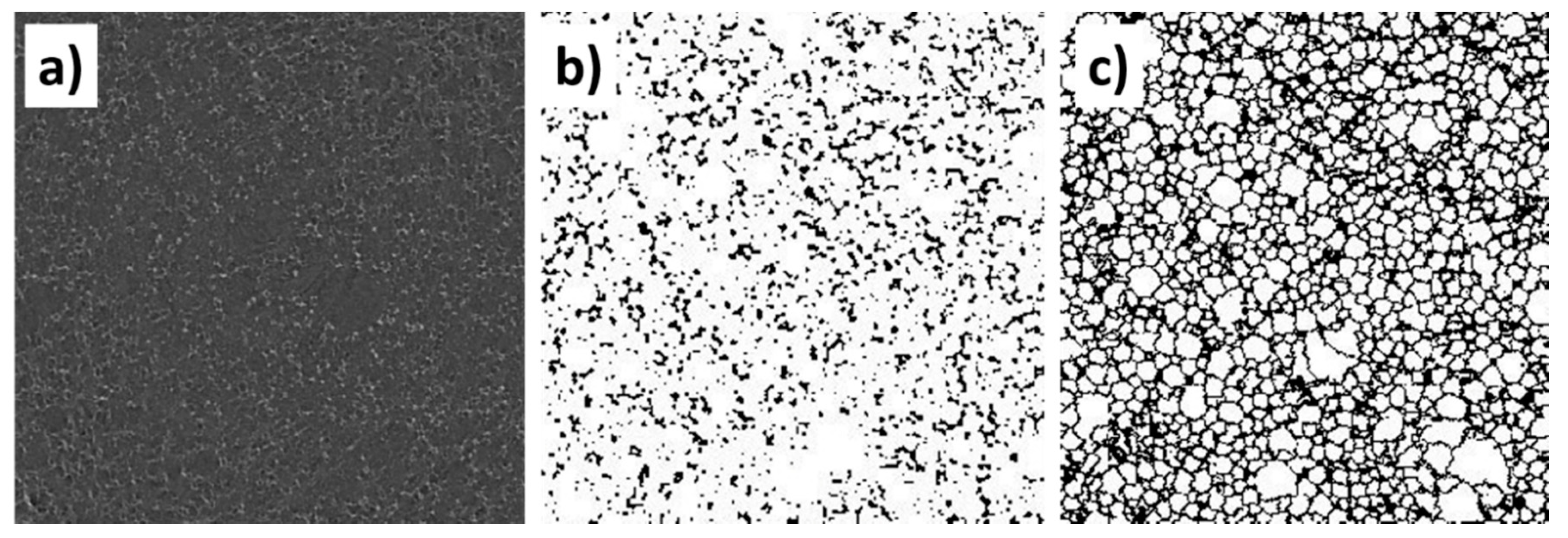
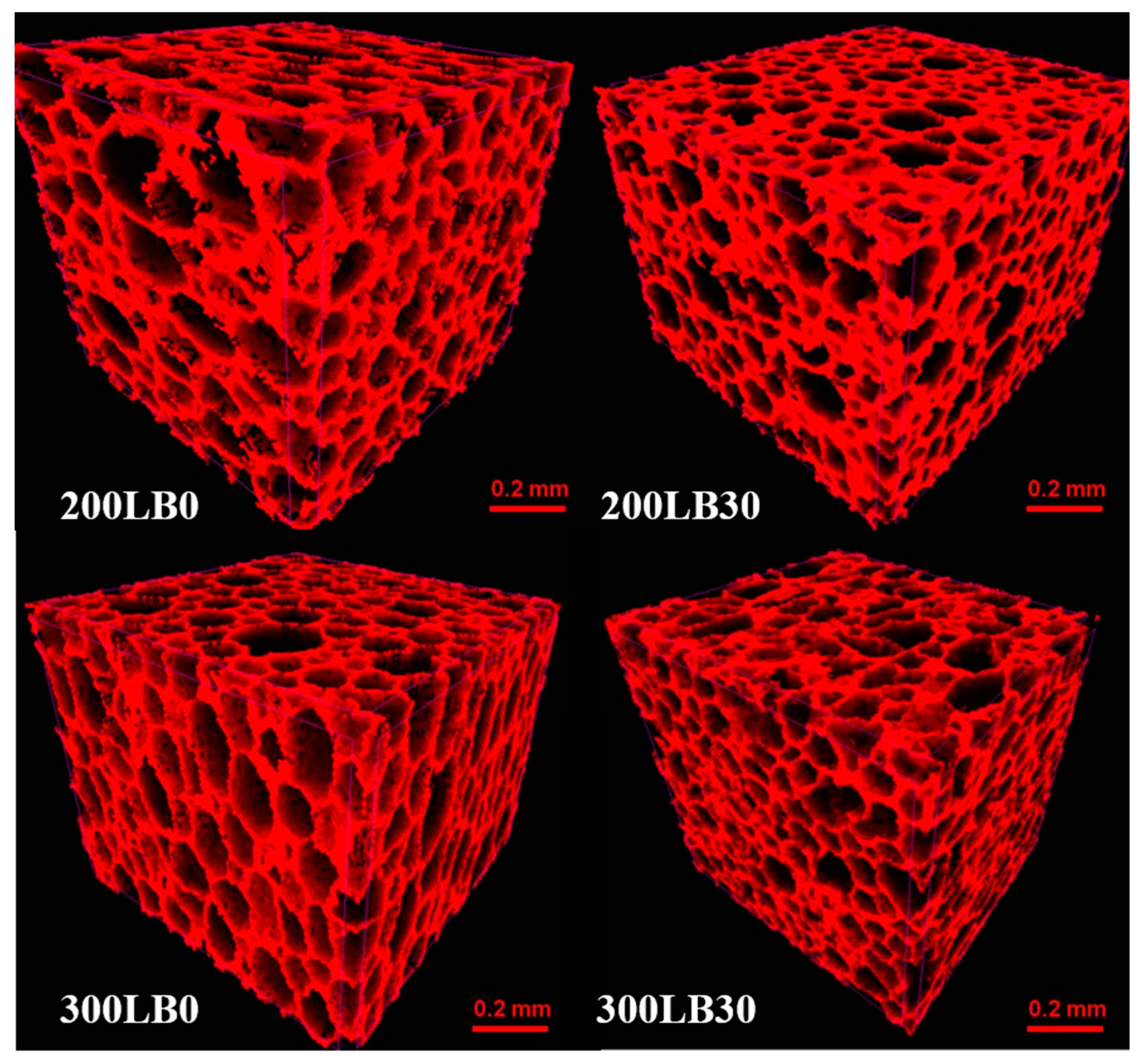

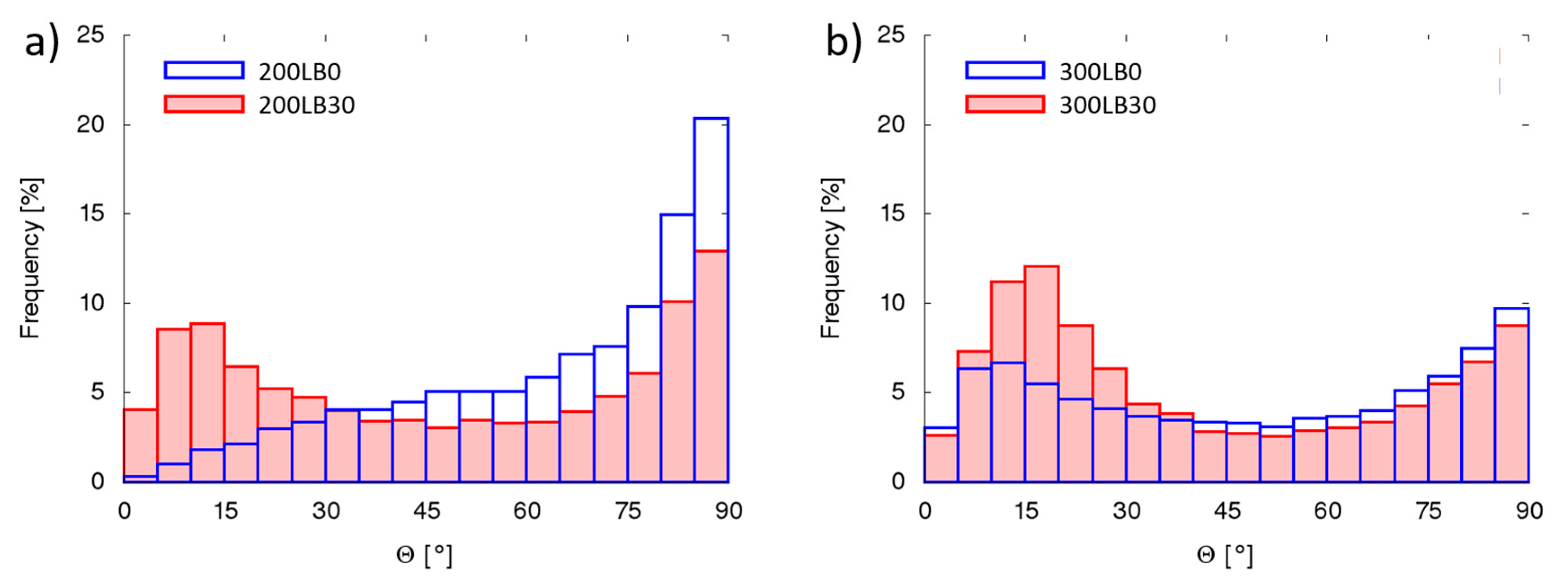
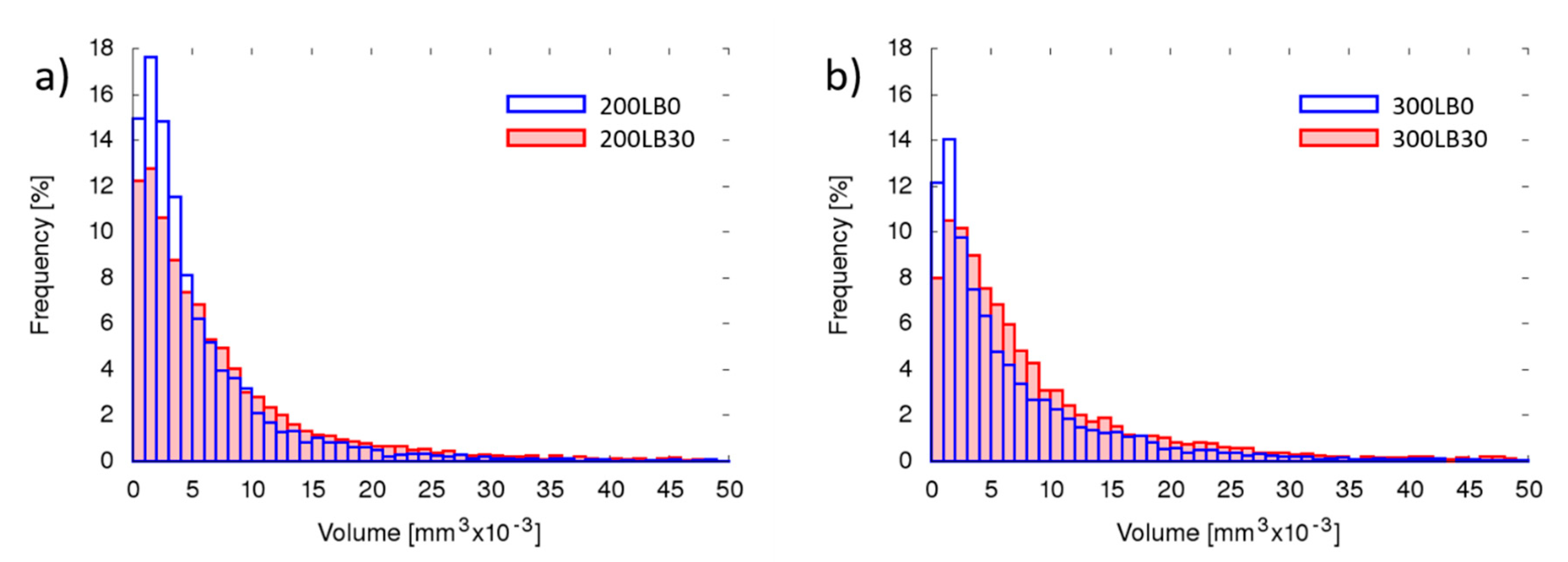
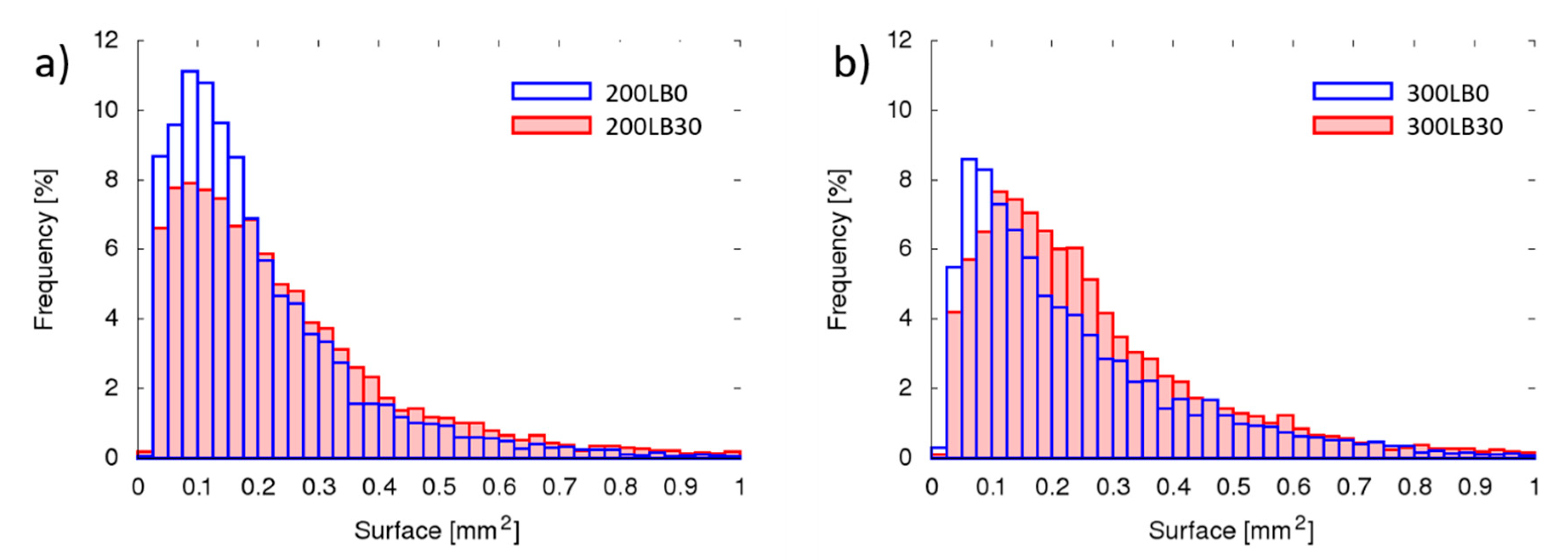



| Polyol | LOH (mgKOH/g) | η (mPa·s) | ρ (g/cm3) |
|---|---|---|---|
| LB | 650 | 2236 | 1.21 |
| Rokopol®RF551 | 440 | 3000–5000 | 1.06 |
| Raw Materials (pbw) | Foam Symbol | |||
|---|---|---|---|---|
| 200LB0 | 200LB30 | 300LB0 | 300LB30 | |
| Rokopol RF551 | 100 | 70 | 100 | 70 |
| Biopoliol LB | 0 | 30 | 0 | 30 |
| AC | 0.5 | 0.5 | 0.5 | 0.5 |
| Dabco 15K | 0.5 | 0.5 | 1 | 1 |
| Dabco 33LV | 0.5 | 0.5 | 0.5 | 0.5 |
| DBTDL | 0.5 | 0.5 | 0.5 | 0.5 |
| TEGOSTAB B 8465 | 6 | 6 | 6 | 6 |
| TCCP | 10 | 10 | 10 | 10 |
| n-pentane | 12.5 | 12.5 | 20 | 20 |
| pMDI | 203.6 | 237.0 | 305.3 | 355.4 |
| Foam Symbol | Apparent Density (kg/m3) | Pore Diameter SEM (µm) | Pore Diameter MicroCT (µm) | Coefficient of Thermal Conductivity (W/m·K) | Thermal Resistance (d = 0.02 m) (m2·K/W) |
|---|---|---|---|---|---|
| 200_LB0 | 49.2 ± 1.8 | 147 ± 26 | 117 ± 21 | 0.0270 | 0.741 |
| 200_LB30 | 49.6 ± 1.3 | 179 ± 25 | 108 ± 22 | 0.0246 | 0.810 |
| 300_LB0 | 49.9 ± 2.2 | 176 ± 30 | 131 ± 25 | 0.0261 | 0.767 |
| 300_LB30 | 52.1 ± 1.2 | 191 ± 38 | 124 ± 17 | 0.0248 | 0.806 |
Publisher’s Note: MDPI stays neutral with regard to jurisdictional claims in published maps and institutional affiliations. |
© 2020 by the authors. Licensee MDPI, Basel, Switzerland. This article is an open access article distributed under the terms and conditions of the Creative Commons Attribution (CC BY) license (http://creativecommons.org/licenses/by/4.0/).
Share and Cite
Kosmela, P.; Suchorzewski, J.; Formela, K.; Kazimierski, P.; Haponiuk, J.T.; Piszczyk, Ł. Microstructure–Property Relationship of Polyurethane Foams Modified with Baltic Sea Biomass: Microcomputed Tomography vs. Scanning Electron Microscopy. Materials 2020, 13, 5734. https://doi.org/10.3390/ma13245734
Kosmela P, Suchorzewski J, Formela K, Kazimierski P, Haponiuk JT, Piszczyk Ł. Microstructure–Property Relationship of Polyurethane Foams Modified with Baltic Sea Biomass: Microcomputed Tomography vs. Scanning Electron Microscopy. Materials. 2020; 13(24):5734. https://doi.org/10.3390/ma13245734
Chicago/Turabian StyleKosmela, Paulina, Jan Suchorzewski, Krzysztof Formela, Paweł Kazimierski, Józef Tadeusz Haponiuk, and Łukasz Piszczyk. 2020. "Microstructure–Property Relationship of Polyurethane Foams Modified with Baltic Sea Biomass: Microcomputed Tomography vs. Scanning Electron Microscopy" Materials 13, no. 24: 5734. https://doi.org/10.3390/ma13245734
APA StyleKosmela, P., Suchorzewski, J., Formela, K., Kazimierski, P., Haponiuk, J. T., & Piszczyk, Ł. (2020). Microstructure–Property Relationship of Polyurethane Foams Modified with Baltic Sea Biomass: Microcomputed Tomography vs. Scanning Electron Microscopy. Materials, 13(24), 5734. https://doi.org/10.3390/ma13245734









